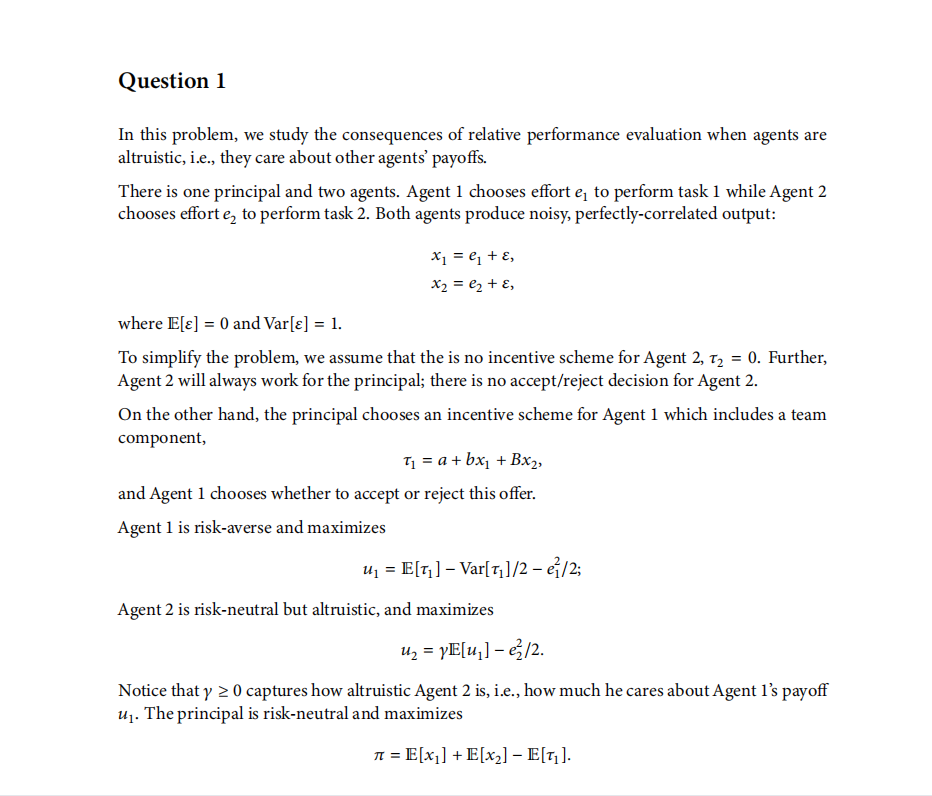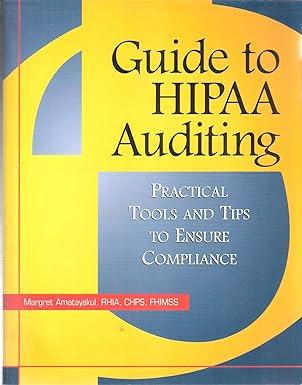

In this problem, we study the consequences of relative performance evaluation when agents are altruistic, i.e., they care about other agents' payoffs. There is one principal and two agents. Agent 1 chooses effort e1 to perform task 1 while Agent 2 chooses effort e2 to perform task 2 . Both agents produce noisy, perfectly-correlated output: x1=e1+,x2=e2+, where E[]=0 and Var[]=1. To simplify the problem, we assume that the is no incentive scheme for Agent 2,2=0. Further, Agent 2 will always work for the principal; there is no accept/reject decision for Agent 2. On the other hand, the principal chooses an incentive scheme for Agent 1 which includes a team component, 1=a+bx1+Bx2, and Agent 1 chooses whether to accept or reject this offer. Agent 1 is risk-averse and maximizes u1=E[1]Var[1]/2e12/2 Agent 2 is risk-neutral but altruistic, and maximizes u2=E[u1]e22/2. Notice that 0 captures how altruistic Agent 2 is, i.e., how much he cares about Agent 1's payoff u1. The principal is risk-neutral and maximizes =E[x1]+E[x2]E[1] So, the timing is: Step 1: Principal offers Agent 1 an incentive scheme 1=a+bx1+Bx2. Step 2: Agent 1 accepts or rejects. If she rejects, the game ends and each agent receives zero outside option. Step 3: Agent 1 chooses e1 and Agent 2 chooses e2. Step 4: The principal pays 1. First, assume for parts (a)-(c) that Agent 2 is moderately altruistic, =1/2. a) Calculate agent 2's optimal choice of effort e2, as a function of b and B. In words, why does agent 2's effort choice depend on the incentive scheme offered to agent 1 ? b) Calculate Agent 1's optimal choice of effort e1, as a function of b. c) Calculate the incentive strengths b and B that the principal optimally offers Agent 1 . (Hint: because only Agent 1 chooses whether to accept, the usual trick for simplifying the principal's optimization problem applies only to Agent 1 , not to Agent 2.) d) You should have found from (c) that the principal does not engage in relative performance evaluation: B=0. Explain, in words, why this is the case. (Hint: your answer should hinge on that fact that Agent 2 is altruistic.) For the remaining parts, assume that Agent 2 is highly altruistic, =1. e) Repeat parts (a)-(c) for the case =1. What effort levels e1 and e2 do the agents choose given the principal's choice of b and B ? f) You should have found from (e) that agent 1 does not exert effort because the principal does not provide any incentives to motivate agent 1: e1=0 and b=0. Explain, in words, why the principal chooses not to motivate agent 1 when agent 2 is highly altruistic. In this problem, we study the consequences of relative performance evaluation when agents are altruistic, i.e., they care about other agents' payoffs. There is one principal and two agents. Agent 1 chooses effort e1 to perform task 1 while Agent 2 chooses effort e2 to perform task 2 . Both agents produce noisy, perfectly-correlated output: x1=e1+,x2=e2+, where E[]=0 and Var[]=1. To simplify the problem, we assume that the is no incentive scheme for Agent 2,2=0. Further, Agent 2 will always work for the principal; there is no accept/reject decision for Agent 2. On the other hand, the principal chooses an incentive scheme for Agent 1 which includes a team component, 1=a+bx1+Bx2, and Agent 1 chooses whether to accept or reject this offer. Agent 1 is risk-averse and maximizes u1=E[1]Var[1]/2e12/2 Agent 2 is risk-neutral but altruistic, and maximizes u2=E[u1]e22/2. Notice that 0 captures how altruistic Agent 2 is, i.e., how much he cares about Agent 1's payoff u1. The principal is risk-neutral and maximizes =E[x1]+E[x2]E[1] So, the timing is: Step 1: Principal offers Agent 1 an incentive scheme 1=a+bx1+Bx2. Step 2: Agent 1 accepts or rejects. If she rejects, the game ends and each agent receives zero outside option. Step 3: Agent 1 chooses e1 and Agent 2 chooses e2. Step 4: The principal pays 1. First, assume for parts (a)-(c) that Agent 2 is moderately altruistic, =1/2. a) Calculate agent 2's optimal choice of effort e2, as a function of b and B. In words, why does agent 2's effort choice depend on the incentive scheme offered to agent 1 ? b) Calculate Agent 1's optimal choice of effort e1, as a function of b. c) Calculate the incentive strengths b and B that the principal optimally offers Agent 1 . (Hint: because only Agent 1 chooses whether to accept, the usual trick for simplifying the principal's optimization problem applies only to Agent 1 , not to Agent 2.) d) You should have found from (c) that the principal does not engage in relative performance evaluation: B=0. Explain, in words, why this is the case. (Hint: your answer should hinge on that fact that Agent 2 is altruistic.) For the remaining parts, assume that Agent 2 is highly altruistic, =1. e) Repeat parts (a)-(c) for the case =1. What effort levels e1 and e2 do the agents choose given the principal's choice of b and B ? f) You should have found from (e) that agent 1 does not exert effort because the principal does not provide any incentives to motivate agent 1: e1=0 and b=0. Explain, in words, why the principal chooses not to motivate agent 1 when agent 2 is highly altruistic








